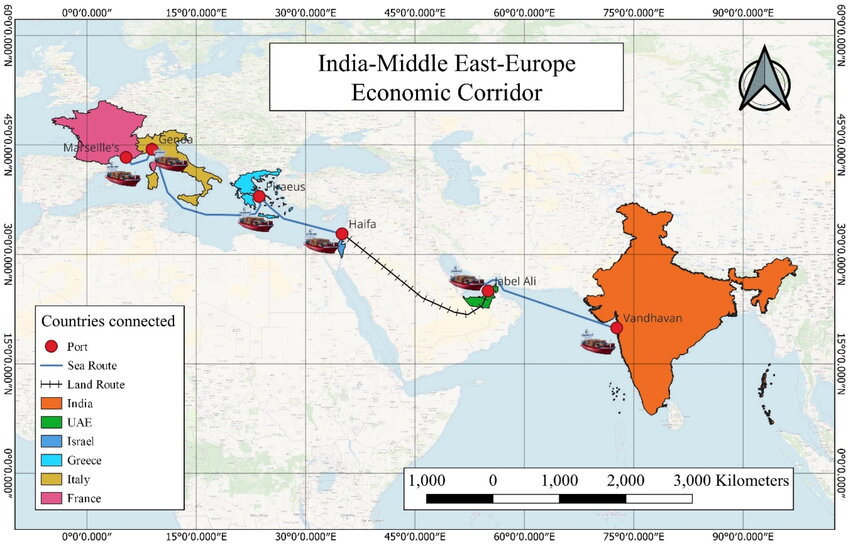
Pics Courtesy Net
Participated in the panel discussion on the India Middle East Europe Economic Corridor (IMEEEC), at the Chandigarh Military Lit Festival 2024.
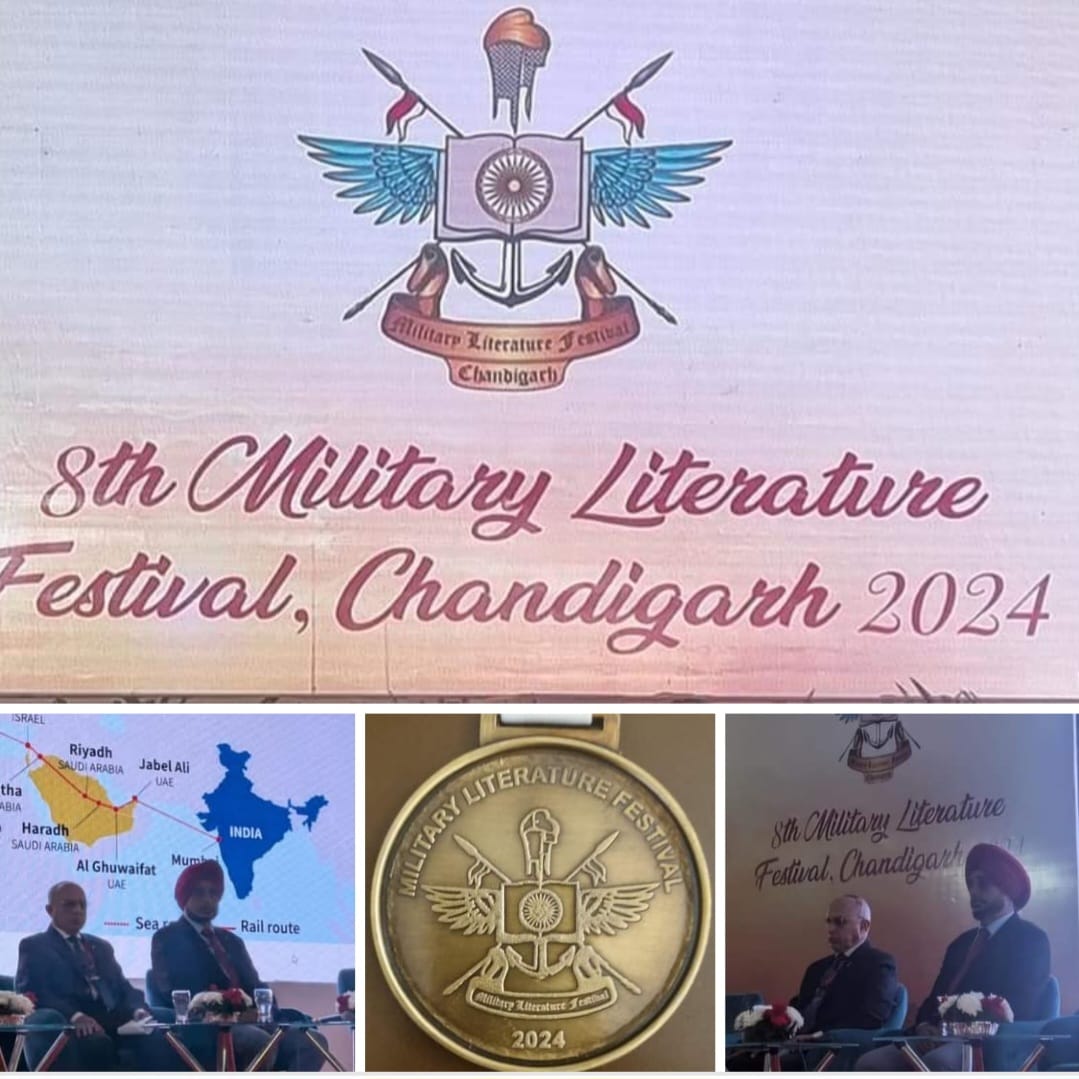
My paper on the security aspects:-
INDIA–MIDDLE EAST–EUROPE ECONOMIC CORRIDOR (IMEEC): MITIGATION OF SECURITY CHALLENGES & THREATS
The India–Middle East–Europe Economic Corridor (IMEEEC) is a proposed initiative to enhance economic connectivity and integration between Asia, the Arabian Gulf, and Europe. Announced on September 9, 2023, during the G20 summit in New Delhi, the corridor is envisioned to facilitate trade and development across these regions. The IMEEEC will be a “game changer” for trade and geopolitics, promising more robust connectivity between Asia, the Middle East, and Europe. However, its success depends on aligning diverse national interests and addressing the geopolitical and security challenges.
INDIA–MIDDLE EAST–EUROPE ECONOMIC CORRIDOR
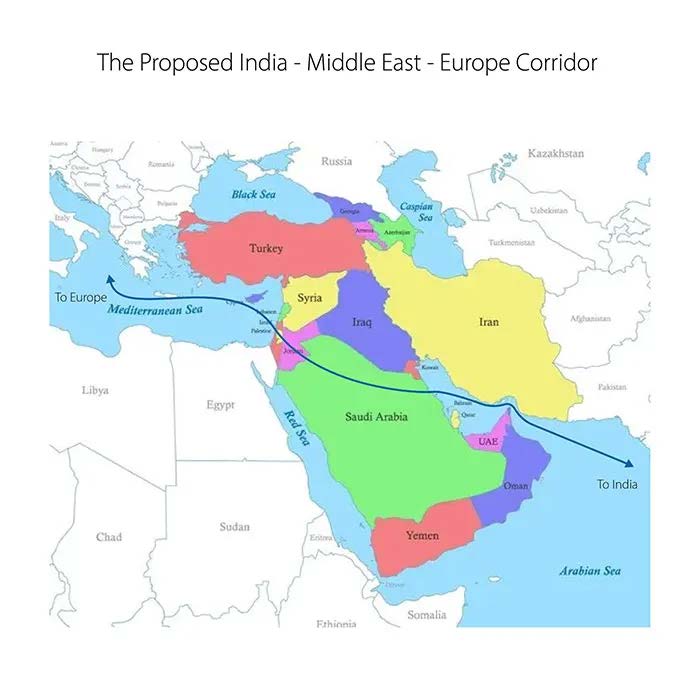
The corridor will connect India to Europe via the United Arab Emirates, Saudi Arabia, Israel, and Greece. It includes an Eastern Corridor (linking India to the Gulf) and a Northern Corridor (linking the Gulf to Europe). It will consist of a railway network providing a reliable and cost-effective cross-border ship-to-rail transit system, supplementing existing maritime and road transport routes. Beyond the transport infrastructure, undersea cables would facilitate data exchange, while long-distance hydrogen pipelines would boost the participants’ climate and decarbonisation goals. Its integration into regional strategies emphasises connectivity and infrastructure investment. The IMEC aligns with energy security and climate resilience objectives, including green hydrogen and renewable energy collaborations.
Objectives. The IMEEEC is a strategic initiative to foster economic growth and strengthen ties. It involves several nations and entities, including India, the United States, Saudi Arabia, the United Arab Emirates, the European Union, France, Germany, and Italy. The primary goals of IMEEEC are to:-
-
- Stimulate Economic Development: Enhancing connectivity and economic integration between the participating regions.
-
- Secure Regional Supply Chains: Providing alternative routes and reducing dependence on existing trade routes like the Suez Canal.
-
- Promote Environmental Sustainability: Focusing on clean energy and reducing greenhouse gas emissions.
Strategic Importance. The India–Middle East–Europe Economic Corridor (IMEEEC) is not just an economic initiative but also a significant geopolitical project that has the potential to reshape regional dynamics, global trade routes, and power structures. It is considered a counterbalance to China’s Belt and Road Initiative (BRI). While the BRI focuses on expansive infrastructure projects under China’s leadership, the IMEEEC emphasises multilateral cooperation, with India, the Middle East, and Europe taking centre stage. By providing an alternative trade route, the corridor reduces reliance on China-centric supply chains and offers participating countries a way to diversify their geopolitical alliances.
Current Status. The India–Middle East–Europe Economic Corridor (IMEC), announced in September 2023, is in its early planning and implementation stages. In February 2024, India and the UAE signed the first formal agreement for the corridor’s development. European nations like Greece and France have also shown active involvement, with France appointing a special envoy to the project. In May 2024, India and the United Arab Emirates held inaugural discussions to advance the IMEEEC corridor, focusing on streamlining cargo movement and enhancing trade connectivity.
Benefits of India–Middle East–Europe Economic Corridor
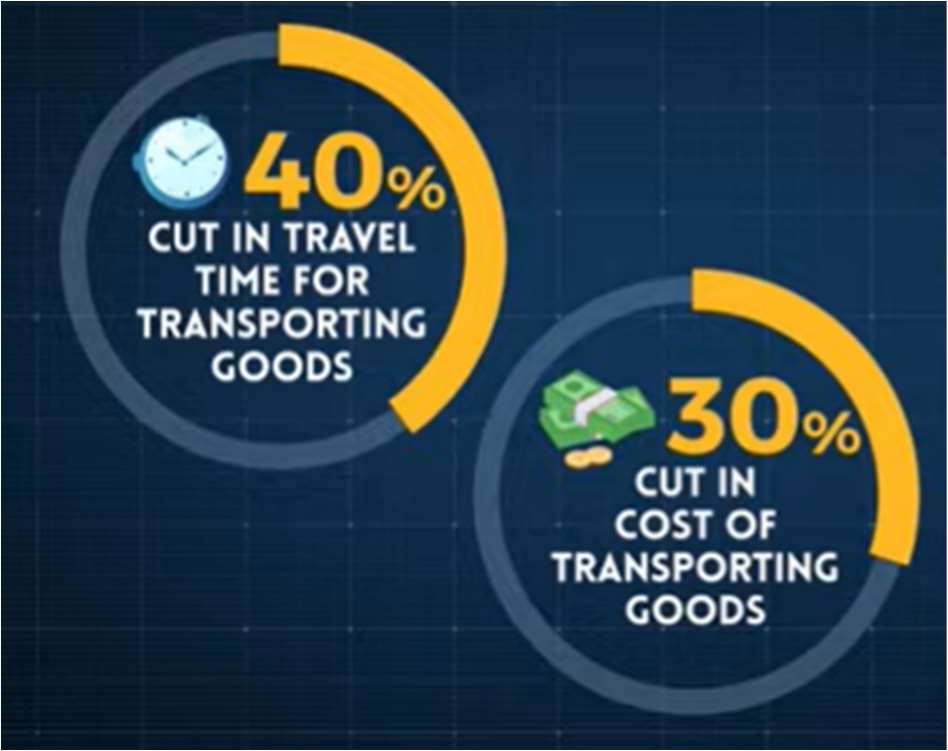
The India–Middle East–Europe Economic Corridor (IMEEEC) offers transformative benefits, from bolstering economic growth and strengthening geopolitical alliances to promoting sustainability and advancing technology. As a strategic initiative, it promises to redefine trade, enhance connectivity, and promote sustainable development across its participating regions. It is beneficial to all the participants.
-
- India’s Role. IMEEEC enhances India’s position as a rising global power and manufacturing hub, enhancing its ability to engage strategically with the Gulf and Europe.
-
- Middle East. The corridor leverages the geographical position of Gulf nations, particularly Saudi Arabia and the UAE, strengthening their roles as logistical and energy hubs and diversifying their economies.
-
- Europe’s Connectivity. It offers European nations an alternative trade route for accessing Asian markets and reducing supply chain vulnerabilities.
Economic Benefits. The Corridor will enhance trade efficiency by providing faster trade routes. It aims to reduce transit times and costs by offering a multimodal transportation network integrating ship-to-rail connectivity, bypassing the congestion-prone Suez Canal. It will provide access to critical markets and facilitate seamless trade between Asia, the Gulf, and Europe, creating a vast economic network connecting major global economies. The corridor’s infrastructure development will attract foreign direct investment (FDI) and create jobs in the construction, logistics, energy, and technology sectors.
Geopolitical Benefits. The project aligns with nations’ interests, seeking non-aligned cooperation models that enhance economic ties without overly depending on a single global superpower. It will strengthen relations between participating countries, promote collaboration among diverse nations and foster stability and mutual economic growth in strategically significant regions.
Technological and Digital Benefits. The corridor includes plans to lay fibre-optic cables, enhance digital communication, and enable smart trade networks across the regions. It will facilitate technological collaboration in artificial intelligence, logistics, and trade monitoring. The project will transfer technology and expertise across regions by integrating advanced infrastructure and energy systems, benefiting participating economies.
Supply Chain Resilience. The corridor bypasses critical chokepoints like the Suez Canal, offering a resilient alternative for global trade. This is crucial in mitigating risks from geopolitical instability or blockages in traditional routeslike the Suez Canal. A streamlined supply chain will ensure the timely delivery of goods and strengthen resilience to disruptions in global trade networks.
Environmental Benefits. IMEEEC incorporates clean energy components like hydrogen pipelines, aligning with global efforts for decarbonisation. The corridor’s focus on rail and clean energy transport will help lower greenhouse gas emissions associated with global trade. It will promote eco-friendly transportation networks with a lower carbon footprint than traditional maritime routes.
Cultural and People-to-People Connectivity. The corridor will strengthen cultural ties and exchanges between Asia, the Middle East, and Europe. It will facilitate tourism and mobility by improving regional connectivity and infrastructure.
Challenges and Threats
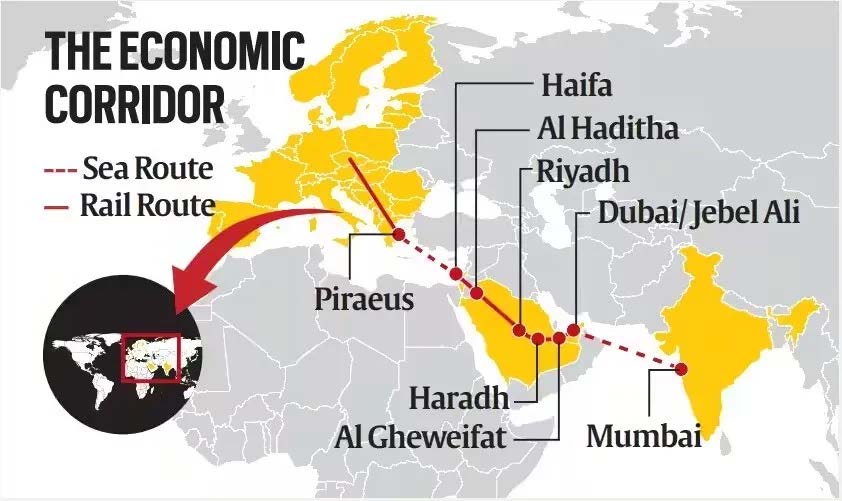
While ambitious and promising, the India–Middle East–Europe Economic Corridor (IMEEEC) faces numerous challenges spanning geopolitical, technical, and financial domains. The success of IMEEEC hinges on the political and economic stability of its key transit regions. Instability in any participating country could disrupt the entire corridor. These hurdles must be addressed to ensure the project’s feasibility and success.
Geopolitical Instability. Regional Conflicts like the ongoing Israel-Hamas war and broader Middle Eastern instability would threaten and raise concerns about the corridor’s security and stability, particularly in critical areas like the Red Sea and Gulf. Frequent disruptions could be caused due to Houthi-type attacks on shipping lanes, underscoring the risks of relying on Middle Eastern transit routes. Regional rivalries, such as between Iran and Saudi Arabia, could disrupt cooperation or sabotage infrastructure. The IMEEEC is viewed as a counter to China’s Belt and Road Initiative (BRI), potentially leading to strategic pushback from China, which could leverage its partnerships (e.g., with Iran or Pakistan) to counter the corridor’s influence.
Diverging National Interests. Participating nations—India, Saudi Arabia, the UAE, and the EU—have differing priorities for the corridor. Balancing these interests while ensuring cooperation remains a significant challenge. Countries like Saudi Arabia and the UAE are pursuing multi-alignment strategies and maintaining ties with the West and rivals like China, which could lead to conflicting commitments affecting the corridor’s long-term alignment.
Economic Challenges. The infrastructure investment required for rail, ports, energy pipelines, and digital connectivity is enormous. Securing sustained funding and balancing returns on investment will be critical. Established trade routes, such as the Suez Canal, continue to dominate due to familiarity with the existing infrastructure. Convincing stakeholders to shift trade flows could be challenging.
Infrastructure Development Challenges. Integrating multimodal rail, road, sea, and energy pipeline systems across diverse geographies would require advanced logistics and technological collaboration. Diverging priorities and differences in national interests among participants could delay decision-making or create inefficiencies in implementation. For example, India may prioritise trade efficiency, while Gulf nations focus on energy export diversification.
Political and Institutional Coordination. Establishing uniform regulations, trade policies, and customs frameworks across multiple countries is critical but challenging and would require policy harmonisation. Countries involved may need more bureaucratic or institutional capacity to handle such a complex, cross-border project.
Environmental and Social Concerns. While green energy is a focus, large-scale infrastructure projects often raise environmental and social concerns, such as land acquisition and displacement. Extreme weather events, rising sea levels, and other climate-related challenges may affect long-term infrastructure resilience.
Security and Strategic Risks. Vulnerabilities in the Red Sea, Gulf waters, and overland transport routes pose risks to trade flow. China’s Belt and Road Initiative (BRI) and potential pushback from non-participating powers like Iran could create additional hurdles. External powers like Russia or China might leverage regional instability to disrupt the corridor’s progress, viewing it as a competitor to their strategic initiatives. Countries excluded from the corridor, such as Iran or Turkey, may view it as a threat to their economic or geopolitical interests and act to undermine its development.
Security Aspects
The security aspects of the India–Middle East–Europe Economic Corridor (IMEEEC) are critical to its successful implementation and operation. Given the corridor’s strategic importance, multiple factors must be considered to safeguard its infrastructure, trade routes, and stakeholders.
Maritime Security
-
- Vulnerabilities in Strategic Waters: The corridor relies on key maritime routes through the Red Sea, Persian Gulf, and Mediterranean Sea. These are vulnerable to piracy, terrorist activities, and geopolitical tensions. Recent attacks on shipping lanes in the Red Sea, such as Houthi operations, highlight the risks to cargo and energy transportation.
- Chokepoints and Blockades: Critical chokepoints like the Strait of Hormuz and Bab-el-Mandeb are susceptible to blockades or military conflict, which could potentially disrupt trade flows.
-
- Naval Protection: Ensuring safe passage for goods requires increased naval collaboration among IMEEEC participants, including India, the Gulf States, and European nations.
Land Route Security
-
- Terrorism and Insurgency Risks: Overland routes passing through politically sensitive regions in the Middle East could be targets for terrorist groups or insurgencies, such as those in Syria, Yemen, or Iraq. Infrastructure projects like railways, pipelines, and highways may face sabotage risks, particularly in areas lacking robust governance.
- Border and Customs Security: Secure and efficient border management is essential to prevent illegal trade, smuggling, or other disruptions along the corridor.
Cyber Security
-
- Digital Infrastructure Risks: The corridor’s digital backbone, including fibre-optic cables and data-sharing platforms, is susceptible to cyber attacks that could disrupt trade or compromise sensitive information. Participating nations must collaborate on cyber security frameworks to safeguard these systems.
-
- Technological Collaboration: Integrating secure technologies, including blockchains for transparent supply chain management, can reduce vulnerabilities.
Energy Security. Critical Energy Infrastructure: Pipelines for green hydrogen and other energy resources are integral to the IMEEEC. These assets are at risk of sabotage or terrorist attacks. Protecting energy supply chains involves deploying advanced monitoring systems and international cooperation on threat mitigation.
Air Threats. Air threats to the IMEEC pertain to the vulnerabilities of infrastructure, supply chains, and participating nations’ security in the context of aerial domains. Air threats underscore the need for comprehensive security measures, both physical and digital. Ensuring aerial safety through coordinated efforts, investment in advanced technology, and robust international cooperation will be essential to the corridor’s success and resilience.
Drone and Missile Attacks
-
- Weaponised Drones. The growing use of drones in conflicts, particularly in the Middle East, poses a significant threat. Non-state actors like the Houthis in Yemen have used drones to target infrastructure, including oil facilities and ports. Similar attacks could disrupt IMEEEC operations. Advanced drones can target key corridor elements, such as railway systems, pipelines, and cargo hubs.
-
- Missile Strikes. Hostile nations or insurgent groups could use ballistic or cruise missiles to target critical infrastructure, especially in the Gulf region. Regional rivalries, such as those involving Iran and Saudi Arabia, amplify this threat.
Airspace Security and Geopolitical Conflicts.
-
- Restricted or Contested Airspaces: Conflicts in the Middle East, such as the Israel-Hamas war, may lead to restricted or contested airspaces, which can delay or reroute cargo flights and reduce operational efficiency. Potential future conflicts could escalate to involve airstrikes that directly or indirectly impact the corridor’s infrastructure.
-
- No-Fly Zones: Political tensions could lead to the imposition of no-fly zones, complicating the movement of goods via air and undermining the corridor’s efficiency.
Terrorism and Aerial Hijacking.
-
- Aerial Terrorism: Commercial or cargo flights associated with the corridor could be targets for hijacking or aerial sabotage by terrorist organisations operating in the region.
-
- Attacks on Airports: Key air logistics hubs in participating nations (e.g., Dubai, Riyadh, Mumbai, and European capitals) could face threats from terror groups seeking to disrupt the corridor.
Conflict-Related Military Air Operations.
-
- Interference by Rival Nations: Military air operations by nations opposing the corridor’s objectives (e.g., non-aligned states or rivals like Iran) could create disruptions. Surveillance flights or show-of-force manoeuvres by adversaries could intimidate stakeholders or delay operations.
-
- Air Defence Systems: Nations along the corridor may deploy advanced air defence systems to protect critical infrastructure. However, miscommunication or misidentification during regional conflicts could lead to accidental escalations.
Protecting IMEEEC
Protecting the IMEEEC requires a multifaceted approach encompassing geopolitical, economic, and security dimensions. Ensuring its success and security involves addressing several key challenges and strategies
Geopolitical Stability.
-
- Addressing Regional Conflicts: Stability in the Middle East, particularly in areas like the Gulf, is critical. Regional powers such as Saudi Arabia, the UAE, and Iran must be engaged diplomatically to minimise conflicts.
-
- Multilateral Cooperation: Strong partnerships among participating countries (India, Saudi Arabia, UAE, Israel, Jordan, and European nations) are vital to maintaining the corridor’s integrity. Organisations like the UN and regional blocs (e.g., the EU, GCC) can help mediate disputes.
-
- Countering External Threats: Rival powers or non-aligned nations might attempt to undermine the corridor. Pre-emptive diplomacy is essential to prevent opposition, particularly from China and Pakistan.
Security Measures
-
- Maritime Security: The corridor relies heavily on sea routes (Arabian, Red, and Mediterranean). Navies of participating nations must collaborate to counter piracy and secure critical chokepoints like the Strait of Hormuz, Bab el-Mandeb, and the Suez Canal.
-
- Cyber security: Digital infrastructure along the corridor, including smart ports and communication systems, requires robust protection against cyber attacks. Strengthening the cyber security of aviation systems to prevent hacking or sabotage.
-
- Counterterrorism: Enhanced surveillance and intelligence-sharing are crucial to preventing militant groups from targeting critical infrastructure.
-
- Advanced Air Defence and Monitoring: To ensure safe and uninterrupted aerial operations, establishing airspace security agreements among IMEEEC participants. Deploying missile and drone defence systems in vulnerable areas, such as ports and logistics hubs.
-
- Energy Security: The corridor involves pipelines and power grids; safeguarding these from disruption is key to operational stability.
Infrastructure Development and Maintenance. Building robust and sustainable infrastructure that can withstand political instability, climate change, or sabotage is crucial. This includes building redundancy in air logistics and ensuring rapid adaptability in case of rerouting or disruptions.
Strategic Partnerships and Alliances. Quad and I2U2: Collaboration between India, the US, UAE, and Israel through platforms like the I2U2 Group or the Quad can enhance security and investments. Given its terminal role in the corridor, the EU should be a key player in financing and protecting the project. As a global guarantor of maritime freedom and a key promoter of the IMEC, continued US interest is critical for the corridor’s protection.
Economic Integration and Public Support. Enhancing trade benefits for nations along the corridor will encourage cooperation and shared responsibility for security. Involving local communities along the route in economic benefits can deter sabotage or insurgency.
Conclusion
The IMEEEC is a geostrategic initiative reflecting the shifting power balance in a fragmented world. Enhancing connectivity, reducing reliance on traditional chokepoints, and fostering sustainable energy partnerships address some of the most pressing geopolitical and economic challenges. The corridor could reshape global trade networks, enhance supply chain resilience, and counterbalance China’s Belt and Road Initiative if fully implemented. The IMEEEC’s potential to transform global trade is counterbalanced by significant challenges requiring sustained political will, robust institutional frameworks, and effective conflict management. Addressing these issues will be critical for the project’s long-term viability. The IMEEEC’s success depends on navigating complex geopolitical rivalries, economic constraints, security threats, and environmental risks. Sustained multilateral cooperation, robust conflict mitigation strategies, and secure funding mechanisms will be essential to counter these threats and realise the corridor’s full potential. Ensuring the security of the IMEEEC requires addressing a complex mix of maritime, land, cyber, and political risks. Collaborative efforts among participating nations, supported by robust multilateral frameworks, will mitigate threats and ensure the corridor’s long-term viability.
Your valuable comments are most welcome.
For regular updates, please register your email here:-
References and credits
To all the online sites and channels.
References:-
- Ministry of External Affairs, India. India’s Vision for IMEEC: Security and Economic Opportunities. New Delhi: Government of India.
- United Nations Economic and Social Commission for Asia and the Pacific (UNESCAP). Regional Economic Integration and Security Corridors: The Case of IMEEC. Bangkok: UNESCAP.
- International Institute for Strategic Studies (IISS). Emerging Trade Corridors and Global Security Risks. London: IISS.
- Brookings Institution. India-Middle East-Europe Economic Corridor: A New Era for Global Trade. Washington, D.C.: Brookings.
- Institute for Defence Studies and Analyses (IDSA). India’s Strategic Role in Global Trade Corridors. New Delhi: IDSA.
- Chatterjee, P., & Mahapatra, D. Geopolitics and Global Trade Routes: A Study of Strategic Corridors. New Delhi: Sage Publications.
- Bhadrakumar, M. K. Middle East: Security, Diplomacy, and Trade Routes. London: Routledge.
- Raghavan, S. India and the Middle East: Historical and Strategic Ties. Oxford: Oxford University Press.
- Kumar, R., & Ahmad, F. “Geostrategic Implications of the IMEEC on Regional Security,” Journal of International Affairs, 45(3), 78-95.
- Al-Mansoori, Y., & Patel, A. “Energy Security and Economic Corridors: Analyzing the Role of IMEEC,” Middle East Policy Journal, 30(2), 112-129.
- Verma, P. “India’s Security Challenges in the Middle East: A Corridor Perspective,” Strategic Studies Quarterly, 16(1), 34-58.
- World Economic Forum. (2023). “IMEEC: Building a New Trade Link Between Asia, the Middle East, and Europe.” weforum.org.
- Carnegie Endowment for International Peace. (2023). “Security Implications of New Trade Corridors.” carnegieendowment.org.
Disclaimer:
Information and data included in the blog are for educational & non-commercial purposes only and have been carefully adapted, excerpted, or edited from reliable and accurate sources. All copyrighted material belongs to respective owners and is provided only for wider dissemination.
